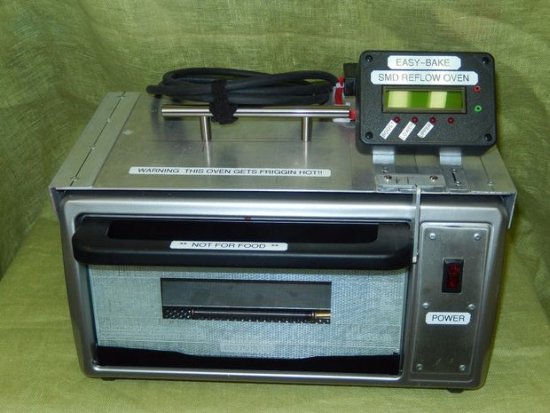I have been an electronics hobbyist for many years and have always stuck with through-hole components when making a project. However as time goes by, not only are more and more components are becoming available only in SMD (surface mount device) but also more interesting projects are also SMD based.
There are several options for doing your own SMD soldering:
Hand Soldering – Using a fine-tipped soldering iron and small-diameter solder you can work with the larger of the SMD devices. However it can be pretty tedious and take a long time if you have lots of parts.
Electric Frying Pan – This can work for smaller boards but the temperature control is pretty difficult so it can be hit and miss.
Toaster Oven – This seems the most promising for the hobbyist and while you can just wing it with the manual controls there are also a range of control options for automation and temperature control. This essentially mimics a commercial reflow oven.
I decided to put together a toaster oven and wanted something that could handle large boards and possibly do small production runs. Doing a web search, you will find many options for toaster oven reflow controllers. They range from one-off designs to DIY boards to full kits. A large number of them are Arduino based. Some controllers just allow the oven to plug in (so you don’t need to take the oven apart) while others integrate completely inside the oven (more work but a much better product in the end).
Looking at various options I decided on the Whizoo Controleo2 Reflow Controller. It offers a decent GUI and a self-calibration function that I felt was important to get decent results. It also has full PWM (pulse width modulation) control of the heaters to give you a more accurate temperature profile which is very important in reflow soldering. While I had wanted a kit, the Whizoo is fully assembled but you still have a lot of work to integrate it with your toaster oven. They also offer some extras in the kit including various insulation types (allows the oven to heat up quickly and evenly) and a booster heater (ensures the unit heats up at the correct rate). There is even a servo to crack the door open after the cycle is complete to allow the board to cool correctly. I bought my kit before the servo was available so I rigged up my own servo door opening mechanism. You can see the various purchasing options Here.
Whizoo also has a great Build Guide which details each step. I recommend you read completely through their guide and this Instructable before you start your own oven as there are a few caveats you will run into along the way. You can also find various examples of user made ovens Here.
I also found that the person behind Whizoo (Peter Easton) answers email questions very quickly and at all hours of the night. It is nice to know you get very good support when you purchase a product.
DISCLAIMER!! – This project deals with high voltages and high temperatures. You can easily electrocute yourself and/or burn your house down if you are not careful. Do not attempt this project if you are not competent in the various tasks required and able to do them safely. You will need to make various design decisions during a project of this nature and you need to be able to evaluate the various potential safety issues involved.
Don’t say I didn’t warn you…
Update:
If you are interested in an Instructable on setting up a solder paste dispenser for SMD projects check out this one I just recently publish
Step 1: Find A Toaster Oven
You have many toaster oven options. While you can use something you find in the trash or “borrowed” from the kitchen, I decided to get something new. I didn’t want any chance of contamination from previous food stuff nor did I want to work on something old and nasty. Ideally you want an oven with quartz style heaters as they heat up faster than the old rod style heaters. I went with the same model that Whizoo used in their example: a Black & Decker TO1322SBD. It has quartz heaters (one above and one below) and is rated at 1150 Watts. It will handle a board up to approx. 6″ x 9″ (large enough for anything I expect to do). You can get larger ovens and ovens with convection fans (the Whizoo controller also has a output to control the fan).
For more detail: Making A SMD Reflow Oven

